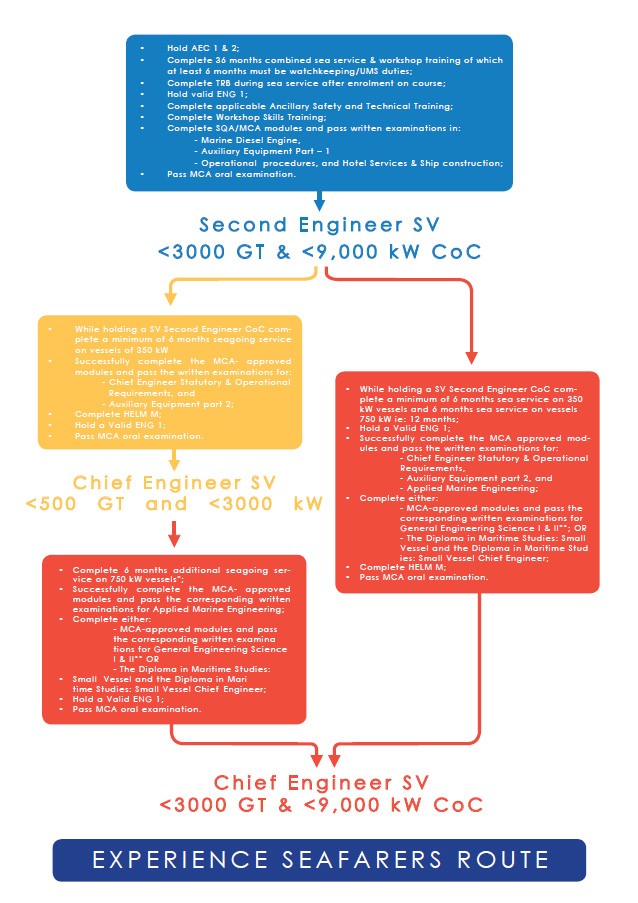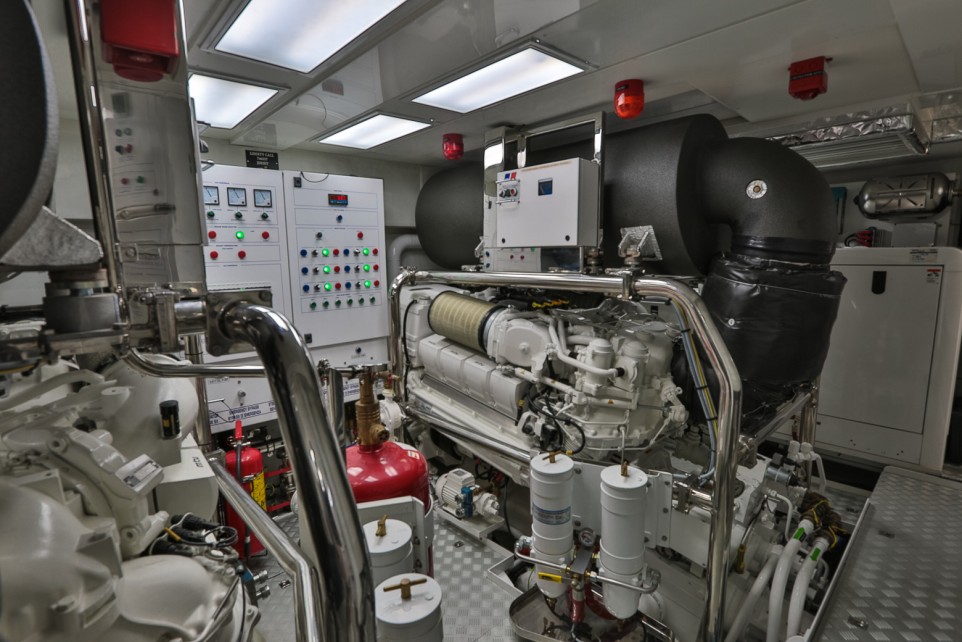This work has now concluded and subject to MCA and UK government agreement, a
Marine Information Note (MIN) has been published (MIN 524) giving the details of the revised structure, there may well be a few final minor amendments to this in due course due to feedback from the working group and stakeholders. This article is aimed at giving an overview of what has been agreed.
Background
A working group was convened where the yachting industry was strongly represented and comprised a wide variety of stakeholders. Delegates from the main UK training providers along-with representatives from the MCA, the International Association of Maritime Institutes , the fishing industry, tugs, offshore support vessels, HMRC, the workboats association, serving yacht engineers and two major engineering institutes were involved in the whole process. There will be Certificates of Competency (CoCs) in the near future that are interchangeable between sectors which will be more relevant to the Small Vessel Engineer and facilitate faster routes to promotion.
Constraints
Initial working group concern was raised about the diversity of small vessel engineers, their vessels, training, sea time and certification. It quickly transpired that all stakeholders had one common aim that change was needed. Progress was made very quickly by like - minded representatives and it became apparent that the machinery, equipment and systems used by all sectors were pretty much the same in size, type, manufacturer and complexity. The predilections of some that a super yacht is completely different to a fishing vessel in terms of certification and training soon evaporated when the cost of Persian rugs and luxury fittings compared to that of a deep sea fishing net and a full catch were found to be somewhat similar ! So it was agreed that the new structure training and qualifications should be centred about commonality and relevance. The qualifications should also be transferable and the offshore limits removed. This excitement had to be moderated by the constraints of the STCW code (capped to 9000kW and 3000GT) but mutually acceptable proposals were agreed at lengthy meetings kindly hosted by the UK Chamber of Shipping. The training needs of the modern engineer were discussed at length and the new routes to certification established. Whilst the new structure is not perfect, the time, opportunity and motive were synergistic enough to agree a way ahead that suited all sectors with a minimum amount of compromise.
Grandfather Clauses
It is worth noting that you can only transfer existing CoC’s to the new Small Vessel CoC, candidates are not able to mix and match old and new modules. Whilst change was needed, the standards and relevance of the new training syllabi were foremost in the working group’s agenda. Subsequently, sensible “grandfather clauses” were introduced so that existing seafarers were not disadvantaged and new training regimes were deemed relevant, achievable and fair.
Flexibility
After consultation with seafarers, there had to be routes for engineers to come into the new system from other sectors and the Merchant Navy and vice versa. Engineers who wish to remain with their current qualifications (and limitations) may do so without penalty. There is a route for those who wish to remain at the same level of CoC but enjoy the benefits of the new system (in that rank) by undertaking and proving sea time AND/OR (still to be decided) undertaking an oral examination. The transferability of the new CoC will be limited to Yachts, Tugs, Fishing Vessels, Workboats, Standby, Seismic Survey, Oceanographic Research Vessels and Government Patrol Vessels at the discretion of the employer.
New Routes to Promotion

Experienced Seafarer's Route © download here: https://goo.gl/RBMBp2
The new routes are shown in the
diagram below and it all starts with the
AEC. There will be no MEO (L) or stand-alone skills test for yachts. Whilst not a CoC, the AEC will be the start point for engineers. It was agreed that the AEC needed to be bigger, better and mandatory to provide a logical stepping stone to the next level. This and the lack of credibility of the “skills test” was the catalyst for a review. The AEC will now be 2 weeks long and mandatory (those already holding AEC and have 3 months sea service whilst holding AEC will not have to do AEC 1 again as this remains unchanged, but will have to undertake Part 2 if embarking on the new structure leading up to the Small Vessel Second Engineer Qualification).
A training record book (TRB) will be issued for all students to progress to the next qualification. The ancillary and safety courses along with HELM requirements are also detailed in the
MIN but are very much the same as the present.
There will be THREE routes to what was Y4 and will now be called the Second Engineer Certificate. It should be noted that the finer details will be contained in the MIN.
Other Benefits and Sea Service
Due to the sporadic use of yachts it was also agreed that each day underway at sea will count as 1.5 days sea service and up to 25% of the sea service requirement may be from harbour, anchor or yard time thus enabling CoC’s to be obtained more quickly.
Three routes to SECOND (EOOW) Engineer (Formerly Y4)
1. Approved Route In basic terms there will be a fast track route for those who study through an approved route of “education” involving academic modules called Maritime Studies Qualifications (MSQ’s). Successful completion will result in the award of a “Diploma in Maritime Studies Small Vessel Engineer”. It is suggested that this route (with much reduced sea time requirement) will suit the super yacht engineer due to the sporadic use of yachts underway at sea for sea time accrual and that some of this learning can be undertaken through blended learning packages on-board, some of it online and in their own time. There will still be a requirement to undertake one week preparation courses and then sit the SQA examinations in Marine Diesels, Auxiliary Equipment Part 1 and Operational Procedures and Basic Hotel Services. The course syllabi have been updated and modified. Larger vessel subjects have been removed and Auxiliary Equipment has been split into 2 parts. Some of the Auxiliary subjects have been moved into Marine Diesels but the harder elements will be encountered at the next higher level CoC called Chief Engineer 3000kW 500GT. The exams (written and oral) have also been modified to match the new syllabi requirements. 2. The Experienced Seafarer Route The New Experienced seafarer route will have some reduced sea time requirement and will now include 2 weeks workshop time (which may be exempted with prior workshop experience in hand tools and fitting). There will still be a requirement to undertake one week preparation courses before sitting the SQA examinations in Marine Diesels, Auxiliary Equipment Part 1 and Operational Procedures and Basic Hotel Services. 3. The HNC / HND route This route will require enrolment at a training college for those with an HNC or HND or part thereof, where the candidates accredited prior learning units will be assessed on a case by case basis by the college to determine the qualifications required for the award of the CoC. They will still have to sit the 3 SQA examinations.
Chief Engineer 3000Kw limited 500GT (Formerly Y3)
This new CoC will replace the old Y3 and will now include a modified Chief Engineer Statutory Operational Requirements course, Auxiliary Equipment 2 and some other subjects taken from other areas to bolster up this qualification to a meaningful higher level internationally recognised qualification. Transfer from Y3 to this new interchangeable qualification can be achieved by proof of sea time or an oral examination. Engineers may remain with their current Y3 CoC and its limitations without penalty.
Chief Engineer 9000Kw limited 3000GT
This CoC replaces Y2 and Y1. There will be two routes available; either from Chief Engineer limited 500GT (as above) or fast track from Second Engineer through the “approved route” with relevant sea time and additional education units resulting in the award of Diploma in Maritimes Studies Small Vessel Chief Engineer. Either way the candidate must successfully complete the MCA-approved modules and pass the corresponding written examinations for:
• Auxiliary Equipment part 2 (not required if Chief Engineer 500GT CoC already held)
• Chief Engineer Statutory and Operational Requirements
• Applied Marine Engineering
And:
Complete either:
• MCA-approved modules and pass the corresponding written examinations for General Engineering Science I & II; OR
• The Diploma in Maritime Studies: Small Vessel Engineer and the Diploma in Maritime Studies: Small Vessel Chief Engineer
Summary of Benefits:
• Area limitations removed for all engineering and interchageability between sectors for each new CoC
• All course syllabi refreshed and made more relevant to the small vessel sector
• Routes to progress to larger Kw certificates and transfer between sectors
• Reduction in Sea time for experienced seafarer route from 42m to 36m
• Even faster route if taking the MSQ route and award of Diploma in Maritime Studies and blended learning benefits (learning at work, on-board on-line time off to study)
• Training Record book required from AEC to Second engineer and subsequent promotions will log experience and can also validate sea service
• AEC mandatory (unless exempt) and in 2 x one week Parts
• Auxiliary Equipment refreshed and split in to 2 parts
• All syllabi refreshed and new exam questions written
• Y3 modernised and now includes Auxiliary 2 and other topics
• Y2 AHS scrapped (although some important bits moved elsewhere in the new syllabus)
• Up to 25% of sea service requirement may be harbour anchor or yard time
• Days underway at sea for yachts = 1.5 days sea service
The MCA website now contains the new syllabi for each course and oral boards.



